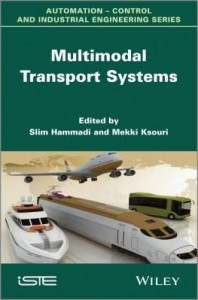The use and management of multimodal transport systems, including car-pooling and goods transportation, have become extremely complex, due to their large size (sometimes several thousand variables), the nature of their dynamic relationships as well as the many constraints to which they are subjected. The managers of these systems must ensure that the system works as efficiently as possible by managing the various causes of malfunction of the transport system (vehicle breakdowns, road obstructions, accidents, etc.). The detection and resolution of conflicts, which are particularly complex and must be dealt with in real time, are currently processed manually by operators. However, the experience and abilities of these operators are no longer sufficient when faced with the complexity of the problems to be solved. It is thus necessary to provide them with an interactive tool to help with the management of disturbances, enabling them to identify the different disturbances, to characterize and prioritize these disturbances, to process them by taking into account their specifics and to evaluate the impact of the decisions in real time.
Each chapter of this book can be broken down into an approach for solving a transport problem in 3 stages, i.e. modeling the problem, creating optimization algorithms and validating the solutions. The management of a transport system calls for knowledge of a variety of theories (problem modeling tools, multi-objective problem classification, optimization algorithms, etc.). The different constraints increase its complexity drastically and thus require a model that represents as far as possible all the components of a problem in order to better identify it and propose corresponding solutions. These solutions are then evaluated according to the criteria of the transport providers as well as those of the city transport authorities.
This book consists of a state of the art on innovative transport systems as well as the possibility of coordinating with the current public transport system and the authors clearly illustrate this coordination within the framework of an intelligent transport system.
Contents 1. Dynamic Car-pooling, Slim Hammadi and Nawel Zangar.
2. Simulation of Urban Transport Systems, Christian Tahon, Thérèse Bonte and Alain Gibaud.
3. Real-time Fleet Management: Typology and Methods, Frédéric Semet and Gilles Goncalves.
4. Solving the Problem of Dynamic Routes by Particle Swarm, Mostefa Redouane Khouahjia, Laetitia Jourdan and El Ghazali Talbi.
5. Optimization of Traffic at a Railway Junction: Scheduling Approaches Based on Timed Petri Nets, Thomas Bourdeaud?huy and Benoît Trouillet. About the Authors Slim Hammadi is Full Professor at the Ecole Centrale de Lille in France, and Director of the LAGIS Team on Optimization of Logistic systems. He is an IEEE Senior Member and specializes in distributed optimization, multi-agent systems, supply chain management and metaheuristics.
Mekki Ksouri is Professor and Head of the Systems Analysis, Conception and Control Laboratory at Tunis El Manar University, National Engineering School of Tunis (ENIT) in Tunisia. He is an IEEE Senior Member and specializes in control systems, nonlinear systems, adaptive control and optimization. The multimodal transport network customers need to be oriented during their travels. A multimodal information system (MIS) can provide customers with a travel support tool, allowing them to express their demands and providing them with the appropriate responses in order to improve their travel conditions. This book develops methodologies in order to realize a MIS tool capable of ensuring the availability of permanent multimodal information for customers before and while traveling, considering passengers mobility.
Each chapter of this book can be broken down into an approach for solving a transport problem in 3 stages, i.e. modeling the problem, creating optimization algorithms and validating the solutions. The management of a transport system calls for knowledge of a variety of theories (problem modeling tools, multi-objective problem classification, optimization algorithms, etc.). The different constraints increase its complexity drastically and thus require a model that represents as far as possible all the components of a problem in order to better identify it and propose corresponding solutions. These solutions are then evaluated according to the criteria of the transport providers as well as those of the city transport authorities.
This book consists of a state of the art on innovative transport systems as well as the possibility of coordinating with the current public transport system and the authors clearly illustrate this coordination within the framework of an intelligent transport system.
Contents 1. Dynamic Car-pooling, Slim Hammadi and Nawel Zangar.
2. Simulation of Urban Transport Systems, Christian Tahon, Thérèse Bonte and Alain Gibaud.
3. Real-time Fleet Management: Typology and Methods, Frédéric Semet and Gilles Goncalves.
4. Solving the Problem of Dynamic Routes by Particle Swarm, Mostefa Redouane Khouahjia, Laetitia Jourdan and El Ghazali Talbi.
5. Optimization of Traffic at a Railway Junction: Scheduling Approaches Based on Timed Petri Nets, Thomas Bourdeaud?huy and Benoît Trouillet. About the Authors Slim Hammadi is Full Professor at the Ecole Centrale de Lille in France, and Director of the LAGIS Team on Optimization of Logistic systems. He is an IEEE Senior Member and specializes in distributed optimization, multi-agent systems, supply chain management and metaheuristics.
Mekki Ksouri is Professor and Head of the Systems Analysis, Conception and Control Laboratory at Tunis El Manar University, National Engineering School of Tunis (ENIT) in Tunisia. He is an IEEE Senior Member and specializes in control systems, nonlinear systems, adaptive control and optimization. The multimodal transport network customers need to be oriented during their travels. A multimodal information system (MIS) can provide customers with a travel support tool, allowing them to express their demands and providing them with the appropriate responses in order to improve their travel conditions. This book develops methodologies in order to realize a MIS tool capable of ensuring the availability of permanent multimodal information for customers before and while traveling, considering passengers mobility.












